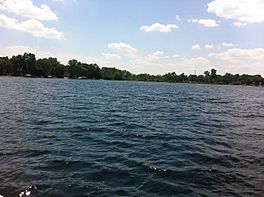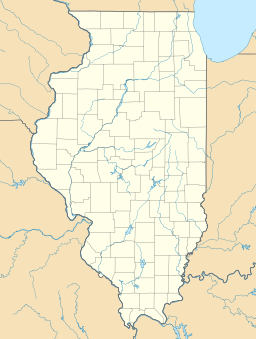Loon Lake (Lake County, Illinois) facts for kids
Quick facts for kids Loon Lake |
|
|---|---|
 |
|
| Location | Lake County, Illinois |
| Coordinates | 42°27′11″N 88°05′08″W / 42.4530°N 88.0855°W |
| Type | Glacial |
| Basin countries | United States |
| Surface area | 334 acres (1.4 km2) |
| Max. depth | 44 feet (13 m) |
| Shore length1 | 6.9 miles (11.1 km) |
| 1 Shore length is not a well-defined measure. | |
Loon Lake is a cool glacial lake located in northern Lake County, Illinois, United States. It's actually made up of three smaller lakes: East Loon, West Loon, and North Loon. (Just so you know, North Loon isn't connected to the others!) You can find it near the town of Antioch, Illinois, close to where Route 83 and Grass Lake Road meet. This lake is a lively home for many different kinds of fish, birds, reptiles, and amphibians. Some of these animals are even endangered species, like the blacknose shiner fish.
Contents
About Loon Lake's Waters
Loon Lake is split into a few different parts, each with its own special features.
West Loon Lake
West Loon Lake is a glacial lake that can get pretty deep, reaching about 38 to 44 feet down. It covers an area of 166 acres (0.7 km2) and has more than 2.1 miles (3.4 km) of shoreline. This part of the lake is super clear! You can often see down 15 to 18 feet into the water, depending on the time of year. In fact, its water clarity has been the best it's been in 15 years.
East Loon Lake
East Loon Lake is also a glacial lake, but it's a bit shallower than West Loon, with a maximum depth of 26 to 28 feet. It's slightly bigger in area, covering 168 acres (0.7 km2), and has a longer shoreline of more than 4.8 miles (7.7 km). East Loon Lake is more of a natural habitat than a place for lots of boating or swimming. Its water isn't as clear as West Loon, usually only letting you see down about 5 to 7 feet.
Protecting Loon Lake's Environment
Loon Lake has faced some environmental challenges over the years.
Past Uses of the Lake
A long time ago, in the late 1800s and early 1900s, West Loon Lake was actually used as a source for ice. People would cut blocks of ice from the frozen lake to use for cooling things.
Dealing with Invasive Species
Sometimes, plants or animals that aren't native to an area get introduced there. These are called invasive species, and they can cause problems for the local ecosystem. Loon Lake has had some of these unwanted visitors. For example, in August 2005, a Caiman (which is a type of small crocodile) was found in East Loon Lake! Also, tiny shellfish called Zebra Mussels have been found in both West and East Loon Lakes. No one is exactly sure how they got there, but it's thought they might have come from Lake Michigan or Geneva Lake in Wisconsin.
Pollution Concerns
While Loon Lake is generally healthy, new buildings and development in the area can sometimes lead to more pollution in the lake. For instance, a company building a store in Antioch was fined for polluting East Loon Lake during construction. It's important to keep an eye on these things to protect the lake's health.
Animals Living in Loon Lake
Loon Lake is home to many different kinds of fish, turtles, and frogs. Here are some of the cool species you might find:
- Largemouth bass
- Walleye
- Muskellunge
- Northern pike
- Bluegill
- Crappie
- Bowfin
- Carp
- Gar
- Channel cat
- Yellow bullhead
- Yellow perch
- Rock bass
- Pumpkinseed
- Hybrid striped bass
- Western painted turtle
- Common snapping turtle
- Bull-frog
- Leopard frog
- American toad
- Warmouth
Images for kids




